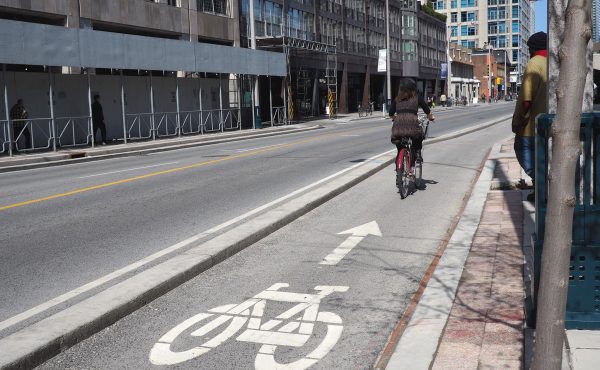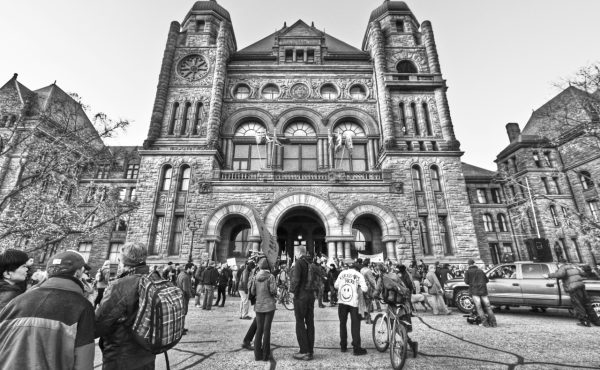During the scrum following Friday night’s shouty debate about priority neighbourhoods, a Global News reporter asked John Tory if he believed that white privilege exists. Tory, in a clip that ricocheted around the city all weekend, denied it, and then attempted to backtrack by talking about the importance of giving people living in communities like Jane-Finch a “hand up.”
At another debate at the C.D. Howe Institute a few weeks ago, Tory also stated that racism wasn’t a factor. Yet despite such denials, discussion over the role of race in this election — which began with the deluge of odious attacks against Olivia Chow — only intensified after Ward 2 candidate Munira Abukar, who is challenging Rob Ford and Andray Domise, tweeted disturbing images of a campaign flyer with her face scrawled out above the words, “Go home.” Kristyn Wong-Tam has also received a stream of hateful correspondence that blends racism and homophobia.
Anyone who professes surprise that the election has exposed this side of the city needs to re-examine their assumptions. Yes, Toronto is a remarkably diverse, and impressively peaceful, city. We haven’t had the sort of racially-fueled riots that tore up suburban areas in Paris and London in recent years. But it doesn’t follow that the absence of such explosive responses to grinding poverty, social exclusion and racial profiling means that all is well.
Still, the racism narrative is complicated. The Fords gave a lot of people permission to publicly express themselves in ways that they might not have indulged in a different political climate. Moreover, the psycho-geography of racism in Toronto is linked to culture, religion, location, and the social-professional origins of specific newcomer communities. This story plays out in lots of different ways.
My concern is that while racism is getting the lion’s share of attention right now, the class divisions that have fueled urban exclusion are being overlooked.
Consider the data. In 2001, University of Toronto sociologist David Hulchanski released a study [PDF] on the gap between the average net worth of homeowners and tenants. The numbers were bracing: he found that the typical net worth of a Toronto homeowner was about $250,000, compared to just $5,000 for tenants, who represent about 50% of the population. “Homeowners’ wealth increased from being 29 times that of renters in 1984 to 70 times that of renters in 1999,” he concluded at the time. Given real estate trends, that gap has almost certainly widened since then.
Hulchanski’s analysis formed the backdrop to his better known Three Cities study [PDF], which reveals how a once predominantly middle-class city gradually and perhaps inexorably sorted itself into enclaves of high-income earners and low income pockets dominated, presumably, by tenants. (Tellingly, the Harper government earlier this month pulled the plug on funding this work.)
Are the interests of City Three — the aggregated zones of increasingly concentrated poverty — well or even adequately represented on Toronto council?
I think not. While the city does aim some programming at lower-income, tenant heavy neighbourhoods — e.g., the Welcome policy for parks and recreation programs, or free dental service — council’s political agenda is largely set by and for homeowners, developers and commercial property taxpayers.
Resident associations and business improvement areas wield real clout with councillors, while tenant councils, when they exist, simply do not. Huge sums pour into Section 37 improvements in neighbourhoods experiencing development spikes, i.e., desirable areas. But council can never find the funds to fix its affordable housing, add more subsidized daycare spaces or provide decent bus service to residents of suburban high-rise communities.
Dubious? Just consider what would happen to a proposal to re-direct all Section 37 dollars to investments in the public realm and community services in the priority neighbourhoods. A total non-starter, that. We don’t really do redistribution.
Now try this thought experiment: imagine how city council would function if voter turnout among homeowers was really low, but tenants came out to cast ballots in large numbers. Quite differently, I’m guessing.
Conventional wisdom holds that the opposite is true, although the evidence is mixed. A new study by the Maytree Foundation [PDF] concludes that ward-level voter turn-out in the past three elections doesn’t seem to be related to the proportion of tenants. Indeed, turnout in some high-tenant/low-income arrival cities, like Thorncliffe Park, is as high or higher than rates in neighbourhoods dominated by single-family homes. But overall, areas with the highest proportion of newcomers tend to have the lowest voter turn-out rates.
University of Toronto political scientist Zack Taylor has also scrutinized voting patterns in the last three elections, and concludes that lower turnout is correlated to neighbourhoods with more foreign-born residents and visible minorities, more low-income residents, and more people who didn’t finish high school or are working in blue collar jobs. While Taylor says the data doesn’t show an explicit connection between housing tenure and voting behaviour, he does point out that recent immigrants do tend to be poorer and are more likely to rent.
The broader point is that a council more oriented towards tenants may be less fixated on keeping tax hikes at or below the rate of inflation. Structurally, the members of my imaginary council may also feel more obliged to dance with the ones that brung ‘em, which means investing in the sorts of services that cater more to low income residents and matter less to those with means.
There’s little doubt that Chow’s platform, as well as Ari Goldkind’s, speaks much more directly to the goal of rebalancing the city’s agenda so it better addresses the needs of the 50% of the population that so often gets the short shrift.
From where I sit, that’s a vitally important conversation.
Yes, the glimpses of the odious racism have revealed a side of Toronto that many would prefer to ignore — or deny. But I’d argue that these incidents — and the political reactions to them — may actually be symptomatic of the fact that we now live in a city that is becoming ever more segregated, a place where people from different socio-economic classes have less and less to do with one another.
Is that a story about racism or class division? Probably both. But let’s not lose sight of the latter as we unpack the significance of the former.






6 comments
Terrific article, great analysis! Since the 2010 election surprise victory of Rob Ford, everyone has been scratching their heads trying to discover why it happened. Now we can see how the Fords used the KISS principle: Keep It Simple Stupid! By deftly using short sound bites (Stop The Gravy Train) coupled with blatant but amazingly persistent lies they bamboozled those that do not follow city hall politics closely (which is probably 98 per cent of us).
Will it happen again in 2014… sure looks like its headed that way.
Toronto will deserve whatever government it elects; I just wish voters cared to check the wild claims before they vote.
I can see the logic of pooling section 37 funds but it is worth noting that many communities that have building booms themselves have been neglected and need to catch up. Most communities are not homogeneous so new libraries or bridges or bike paths do serve a wide selection of people. As well, even built up areas need new infrastructure to handle the increase of people.
I don’t think you can talk about this w/out also talking about gender. Look at the examples you’ve given – they are all aimed at women. All the candidates who sat on their hands, silent, benefitting from the racist attacks: men. Racism, class privilege, sexism/misogyny, homophobia all slamming into one another in this election.
This is an excellent article. Next, I would like to see you explain why the neighbourhoods who would most benefit from a Chow or Goldkind mayoralty are the most likely to vote for a Ford, whose policies hurt them the most.
I’ve tried to ask Ford supporters why and the best I can get from them is “They are like us: they do drugs, the police hassle them.”
John,
Interesting article… but it falls apart with the hypothetical as to “what would it be like if tenants out-voted homeowners.” While it may be comforting to think that government serves the citizens, all governments are disproportionately by the people who fund their budgets.
Tenants are not directly taxed by city council. The properties they live in are taxed, but because it is illegal to pass that tax directly to the tenant, they have no knowledge of the rate, or the impact it has on their life (and would not benefit if it was eliminated).
As such, property owners have a much greater stake in the elections and discussions related to city hall, and their voice is disproportionately heard and dominant. They directly have money in the game: it’s worth their time to participate.
If tenants want to exercise greater influence in the discussion of government and spending, they should insist on paying more taxes. Introduce bicycle licensing. Reintroduce car licensing (but let every property owner dodge it on 2 vehicles.) Charge a $50 head tax on residents… but let property owners waive it for their resident families.
Giving everyone a direct tax stake in the game of politics increases interest and participation. Eliminating the tax burden for the poor entirely ensures that their interests will be entirely overlooked, because impact on the budget (and votes) is minimal if they aren’t happy.
R.
Looking at the various candidates, I would not vote for someone who pledges to keep property tax increases at or below the rate of Inflation (however that may be defined). Circumstances may dictate that property tax increases exceed the rate of inflation in order to maintain city services and invest in infrastructure.